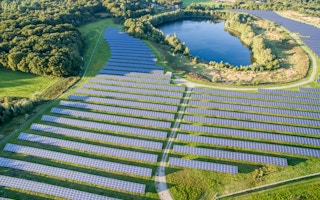Myth 1: More energy is needed to manufacture a solar cell than it will generate under its life cycle, or, alternatively, more CO2 is produced to manufacture a solar cell than it will save under its lifetime.
Fact: Not at all true. Today, the energy payback for silicon solar cells is less than two years. For thin film solar cells the energy payback is less than one year! After that period, energy (and carbon dioxide) is saved and accumulated during the remaining life span of the solar cell (often 25 years). This makes solar cells extremely environmentally friendly.
Myth 2: Solar energy is not financially viable without subsidies.
Fact: Subsidies are being rapidly phased out and technological advancements continue to make solar cells more efficient. Solar energy is now cheaper than purchased electricity (market prices) almost everywhere in the world where the sun shines. There has been a rapid decline in solar energy costs over the last 12 months to the point that it competes favourably with even the cheapest of fossil fuels. A utility owned by US tycoon Warren Buffet recently agreed upon a purchase price of 3.87 cents per kWh from First Solar’s Nevada plant – probably the cheapest electricity price in the US and most of the world.
Myth 3: Once the global warming “scam” is uncovered, no one will be interested in solar energy.
Fact: Whether you believe in global warming or not, and most people do, photovoltaic solar energy is a very attractive way of generating your own electricity at a low foreseeable cost. It is probably the cheapest way to generate electricity in sunny regions and brings energy independence to individuals, corporations and countries alike. It is also a potential job creator. So global warming, believe it or not, really has nothing to do with the benefits of solar energy.
Myth 4: All solar cell manufacturers lose money.
Fact: Some do, but not all. Many manufacturers of silicon solar cells compete in the same segment using the same technology. They are having a tough time. Other segments are more profitable, such as thin, lightweight and flexible solar panels.
The solar energy industry is immature, with constant changes of leadership positions and markets. What we are witnessing is in reality a traditional consolidation phase in a new and fledging industry, with winners and losers, and with the surviving players facing a bright and profitable future.
Among future winners, we must include roof and construction companies with the insight to see building integrated photovoltaics as the ’next big thing’. Solar cells will become better integrated with both roofs and facades, and current manufacturers of construction materials have a great opportunity to gain market shares in this area.
Myth 5: Solar energy will become attractive only when Tesla or any other battery manufacturer commences serial production of cheap and efficient batteries for the storage of electricity.
Fact: See Myth 2. Solar energy is already a very cost competitive source of energy. Cheap and efficient batteries will of course strengthen its attractiveness, but the fact that solar energy is produced when it is demanded the most (i.e. in the middle of the day) makes solar energy less dependent on storage solutions than many other energy sources.
Myth 6: Cheap coal and the current energy mix (often dirty fossil fuel or nuclear) will continue to dominate global energy production for the foreseeable future.
Fact: Don’t bet on it. If you don’t believe me or most scientists, just follow the money. Utility company bonds are being downgraded on Wall Street since their business models – based on power generation monopoly – are being challenged by vast amount of self-generated electricity. The cost of distributed energy generation has dropped significantly, and this has hurt for-profit utilities. In many nations like Germany, solar power has already reached ‘grid parity’.
Myth 7: Solar cells are ugly and an eye sore for landscapes and urban areas.
Fact: Admittedly, current methods of installing traditional silicon solar panels on top of roof tiles does change the architectural expression of many old buildings in a negative way. But the BIPV trend (building integrated photovoltaics) brings solar cells to your neighbourhood without anyone noticing it. Thin film and light weight flexible solar panels can be nicely integrated into the roofing materials resulting in not only pleasant aesthetics but also inexpensive installation.
Myth 8: In the future, solar cells can be painted onto facades with a paint brush.
Fact: Sure, BIPV is very exciting and this myth has spread in popular science but this is not likely, at least not in our lifetime. The third-generation dyed synthesized solar cells are extremely sensitive to humidity and sun light degrades them. They can not be applied with a brush. They must also be encapsulated and connected by series circuit etc.
Myth 9: Thin film solar cells are made by rare earth elements like indium and we will eventually (or soon) run out of them.
Fact: Some scientists and politicians claim that we will run out of rare materials like indium, much as we are depleting the world’s oil reserves. But that is simply not true. Indium, silicon, gallium etc are basic chemical elements as found in the periodic table and are as such indestructable. They cannot “run out”, just change shape, location and application. But there will always be as much indium on earth as there has ever been, and it can be recycled. There is three times as much indium in the earth’s crust than silver but no one claims that we will run out of silver.
Also, solar cell manufacturing equipment suppliers have managed to halve the thickness of thin film solar cells in recent years and in the process greatly reduce the amount of rare materials needed.
Myth 10: In the future everything will be powered by solar energy.
Fact: Well, there is certainly a case for being optimistic about solar energy but the future will bring a diversified energy mix, just as today. The renewable energy portion of the mix will grow, but there will still be a mix of solar, wind, hydro and other energy sources.
Sven Lindström is co-founder, chairman and CEO of Midsummer, a leading global supplier of production lines for cost effective manufacturing of flexible thin film CIGS solar cells. He has over 20 years of experience in international business and development of high tech production equipment and vacuum deposition systems. He has over ten years of experience in the development and management of solar cell production equipment and is a firm supporter of distributed electricity production.


















